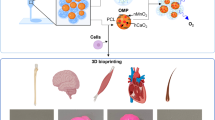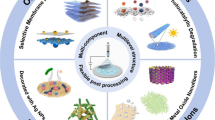Abstract
Establishing fundamentals for regulating cell behavior with engineered physical environments, such as topography and stiffness, requires a large number of cell culture experiments. However, cell culture experiments in cell-surface interaction studies are generally labor-intensive and time-consuming due to many experimental tasks, such as multiple fabrication processes in sample preparation and repetitive medium exchange in cell culture. In this work, a novel aquatic flower-inspired cell culture platform (AFIP) is presented. AFIP aims to facilitate the experiments on the cell-surface interaction studies, especially the medium exchange process. AFIP was devised to capture and dispense cell culture medium based on interactions between an elastic polymer substrate and a liquid medium. Thus, the medium exchange can be performed easily and without the need of other instruments, such as a vacuum suction and pipette. An appropriate design window of AFIP, based on scaling analysis, was identified to provide a criterion for achieving stability in medium exchange as well as various surface characteristics of the petal substrates. The developed AFIP, with physically engineered petal substrates, was also verified to exchange medium reliably and repeatedly. A closed structure capturing the medium was sustained stably during cell culture experiments. NIH3T3 proliferation results also demonstrated that AFIP can be applied to the cell-surface interaction studies as an alternative to the conventional method.






Similar content being viewed by others
References
E. Berthier, E. W. Young, D. Beebe, Lab Chip 12, 1224–1237 (2012)
C. J. Bettinger, R. Langer, J. T. Borenstein, Angew. Chem. Int. Ed. 48, 5406–5415 (2009)
L. J. Burton, N. Cheng, C. Vega, J. Andres, J. W. Bush, Bioinspir. Biomim. 8, 044003 (2013)
K. J. Cha, M.-H. Na, H. W. Kim, D. S. Kim, J. Micromech. Microeng. 24, 055002 (2014)
E. M. Chandler, C. M. Berglund, J. S. Lee, W. J. Polacheck, J. P. Gleghorn, B. J. Kirby, C. Fischbach, Biotechnol. Bioeng. 108, 1683–1692 (2011)
M. J. Choi, J. Y. Park, K. J. Cha, J. W. Rhie, D. W. Cho, D. S. Kim, Biofabrication 4, 045006 (2012)
C. Duprat, J. M. Aristoff, H. A. Stone, J. Fluid Mech. 679, 641–654 (2011)
J. El-Ali, P. K. Sorger, K. F. Jensen, Nature 442, 403–411 (2006)
R. Gómez-Sjöberg, A. A. Leyrat, D. M. Pirone, C. S. Chen, S. R. Quake, Anal. Chem. 79, 8557–8563 (2007)
D. S. Gray, J. Tien, C. S. Chen, J. Biomed, Mater. Res. A 66, 605–614 (2003)
A. W. Holle, A. J. Engler, Curr. Opin. Biotechnol. 22, 648–654 (2011)
F.-Y. Hsu, K.-L. Kuo, H.-M. Liou, J. Taiwan Inst. Chem. E. 43, 165–171 (2012)
C. F. Huang, H. C. Cheng, Y. Lin, C. W. Wu, Y. K. Shen, Int. J. Precis. Eng. Manuf. 15, 689–693 (2014)
P. J. Hung, P. J. Lee, P. Sabounchi, N. Aghdam, R. Lin, L. P. Lee, Lab Chip 5, 44–48 (2005)
S. Jin, J. H. Kim, W. S. Yun, Int. J. Precis. Eng. Manuf. 16, 2235–2239 (2015)
L. Kim, Y. C. Toh, J. Voldman, H. Yu, Lab Chip 7, 681–694 (2007)
E. J. Kim, C. A. Boehm, A. Mata, A. J. Fleischman, G. F. Muschler, S. Roy, Acta Biomater. 6, 160–169 (2010)
H. Liao, A.-S. Andersson, D. Sutherland, S. Petronis, B. Kasemo, P. Thomsen, Biomaterials 24, 649–654 (2003)
I. Meyvantsson, J. W. Warrick, S. Hayes, A. Skoien, D. J. Beebe, Lab Chip 8, 717–724 (2008)
S. Prauzner-Bechcicki, J. Raczkowska, E. Madej, J. Pabijan, J. Lukes, J. Sepitka, J. Rysz, K. Awsiuk, A. Bernasik, A. Budkowski, M. Lekka, J. Mech, Behav. Biomed. 41, 13–22 (2015)
F. Rehfeldt, A. J. Engler, A. Eckhardt, F. Ahmed, D. E. Discher, Adv. Drug Deliv. Rev. 59, 1329–1339 (2007)
P. M. Reis, J. Hure, S. Jung, J. W. M. Bush, C. Clanet, Soft Matter 6, 5705–5708 (2010)
A. Rocha, M. Hahn, H. Liang, J. Mater. Sci. 45, 811–817 (2009)
B. Roman, J. Bico, J. Phys. Condens. Matter 22, 493101 (2010)
J. H. Seo, K. Sakai, N. Yui, Acta Biomater. 9, 5493–5501 (2013)
J. Solon, I. Levental, K. Sengupta, P. C. Georges, P. A. Janmey, Biophys. J. 93, 4453–4461 (2007)
K. H. Song, S. J. Park, D. S. Kim, J. Doh, Biomaterials 51, 151–160 (2015)
Z. Wang, A. A. Volinsky, N. D. Gallant, J. Appl. Polym. Sci. 131, 41050 (2014)
R. J. Whittaker, R. Booth, R. Dyson, C. Bailey, L. Parsons Chini, S. Naire, S. Payvandi, Z. Rong, H. Woollard, L. J. Cummings, S. L. Waters, L. Mawasse, J. B. Chaudhuri, M. J. Ellis, V. Michael, N. J. Kuiper, S. Cartmell, J. Theor. Biol. 256, 533–546 (2009)
E. W. Young, D. J. Beebe, Chem. Soc. Rev. 39, 1036–1048 (2010)
Acknowledgments
This work was supported by Industrial Technology Innovation Program (No. 10048358) funded by the Ministry of Trade, Industry & Energy (MI, Korea) and the National Research Foundation of Korea(NRF) grant funded by the Korea government(MSIP) (No. 2014R1A2A1A01006527).
Author information
Authors and Affiliations
Corresponding author
Rights and permissions
About this article
Cite this article
Hong, H., Park, S.J., Han, S.J. et al. Aquatic flower-inspired cell culture platform with simplified medium exchange process for facilitating cell-surface interaction studies. Biomed Microdevices 18, 3 (2016). https://doi.org/10.1007/s10544-015-0026-y
Published:
DOI: https://doi.org/10.1007/s10544-015-0026-y




